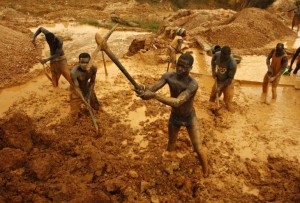Goldfields Mine initiates process to regularise illegal miners’ activities
 Goldfields Tarkwa Mine in the Western Region has initiated processes to bring illegal miners under an umbrella and regularise their activities in the area.
Goldfields Tarkwa Mine in the Western Region has initiated processes to bring illegal miners under an umbrella and regularise their activities in the area.
The mine has started active discussions with the illegal miners in and around its concessional demarcation on the possibility to form an association and support them to go into small scale mining.
Mrs Christiana Yirenkyi, the Senior Environmental Officer of the Tarkwa Mine, said some of the illegal miners were not co-operating but the company would continue to dialogue with them.
Interacting with some journalists at the mine’s plant site at Tarkwa on Wednesday, Mrs Yirenkyi said illegal mining activities in the area was a great burden to the company and there was the need to change the approach in tackling the situation.
The journalists were on a study visit to the mine on the sidelines of a 14-day National Media Training Course on Oil, Gas and Mining being organised by the Penplusbytes, an international ICT Journalism Training Institute, with support from the Natural Resource Governance Institute (NRGI), a Non Governmental Organisation.
Mrs Yirenkyi said it was necessary to sensitise illegal miners of the debilitating effects of their activities on their personal health, the environment and the nation as a whole and also help them to form associations, register and obtain concession to mine.
She said illegal mining activities had destroyed many water bodies in the area and called for a multi-sectoral approach to address the situation.
Mrs Yirenkyi said the company had reclaimed 11.29 per cent of its concessional land disturbed by the activities of the mine since it started actual mining in 1993.
It has planted 629,483 species of economic tree seedlings to restore the natural forest on a 4.54 square kilometre land that was being disturbed by the mine. The tree seedlings include rubber, teak, and mahogany.
Mr Richard Botchey, the Community Affairs Officer of the Tarkwa Mine, said despite the fall in the price of gold last year, the mine continued to invest in its social responsibility programmes in its eight major mine-take communities.
He said the Goldfields Ghana Foundation, established in 2005, had invested about 26 million dollars in community development adding that eight million dollars had also been spent on education.
Mr Botchey said 1,000 students had been awarded scholarships adding that all the communities in the mine’s catchment area had, in one way or the other, benefited from school blocks, health facilities and other social facilities.
But Mr Isaac Abraham, the Public Relations Officer of the Minerals Commission, the regulatory body of the mineral sector, said illegal mining was a national challenge and its fight was putting huge financial burden on the Commission.
According to him, the Commission spent 80 per cent of its annual resources to help bring the activities of the miners under control but was not yielding positive results.
Mr Christopher Opoku-Nyarko, a research officer at the Chamber of Mines, expressed worry about illegal mining and appealed to the Government to take proactive and radical measures to control it.
This notwithstanding, the GNA observed that the illegal miners are making huge economic gains from their unscrupulous activities.
At one of the mining communities around the Anglo Gold Mine in Obuasi, the illegal miners were sighted using traditional methods to refine their gold.
They used locally manufactured implements and crashes to wash and extract raw gold from the ore and worked under sheds.
Kwadwo Bawa, one of the miners who described himself as a local gold retailer at the Ahasonyewodea Community, told journalists that business was good.
Source: GNA
